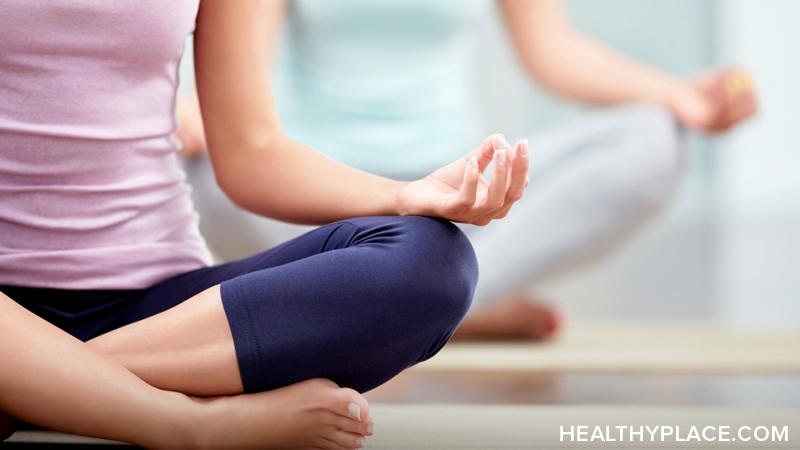How to Use Meditation for Anxiety and Panic Attacks

Meditation is a proven means to drastically reduce anxiety as well as the frequency and intensity of panic attacks. Meditation is the act of being still and creating space between yourself and your problems. It has proven therapeutic powers and can noticeably diminish stress, anxiety, and panic (Chopra et al, 2010). It disrupts obsessive and negative thought patterns and then allows us to restructure our thoughts (Bourne, 2010).
Purpose of Meditation for Anxiety, Panic Attacks, and Stress
The purpose of meditation isn’t to eradicate difficulties in an instant. Instead, the purpose of meditation for panic attacks, anxiety and stress is to help you step away from these experiences and witness them nonjudgmentally from a distance (Bourne, 2010). When we’re tangled in anxious thoughts, struggling against them, we are too trapped to deal with them.
Meditation allows you to become still and quiet, centered. No longer ensnared by problems, you can exist freely. This distance allows you to simply observe yourself and your situations. Rather than thrashing against anxiety and stress, which can lead to panic attacks, you have room to breathe and make choices regarding your actions.
It is this quiet, distant space that brings peace and the ability to deal with stress and anxiety in a way that doesn’t limit your life. Acceptance and commitment therapy calls this defusion because you are defusing, or separating, from your troubles. Bergland (2015) calls it the power to ignore. Whatever you call it, meditation isn’t about getting rid of problems but is instead about helping you create distance.
Physical and Mental Benefits of Meditation for Anxiety
Mediation works because it produces changes in the mind and body. Numerous studies (Balch, 2012; Bemis, 2008; Bergland, 2015; Chopra et al, 2010) have demonstrated that meditation
- produces alpha waves in the brain, the brainwaves associated with relaxation,
- induces overall relaxation,
- increases awareness,
- decreases heart rate,
- lowers respiratory rate,
- reduces blood pressure,
- increases blood flow to the brain, and
- physically changes the brain and its behavior.
Initially, these changes are short-lived and almost imperceptible. When meditation is a regular part of your life, the changes become permanent and you are able to feel the peace and calm.
How to Use Mediation for Anxiety, Panic Attacks, and Stress
Types of Meditation
There isn’t a wrong way to meditate. As you learn how to use meditation for anxiety, panic attacks, and stress, try these different methods to see what feels right for you.
- Structured meditation involves using a focus object (something in the room, an object you hold, etc.). Breathe slowly and deeply, and concentrate on your object. When your mind wanders, gently return your focus to the object.
- In unstructured meditation, you don’t try to pay attention to anything. You just let your thoughts wander without judging or sticking to any of them.
- Mantra meditation uses a single syllable, word, or phrase. This pairs well with affirmation. Repeating an affirmation while meditating helps you focus as well as restructure your thoughts.
- Breathing meditation has you counting your breaths, either silently or aloud. All meditation involves breathing slowly and deeply; this type uses breath counting for concentration.
- Mindset meditation (Imparato, 2016) uses visualization to help create the life you want. Similar to affirmations, visualization allows you to hold an image of your values and dreams and concentrate on it. This trains your brain to shift its focus from anxiety to your values.
Meditation for Anxiety Tips
Sitting quietly and calming the mind doesn’t come easily for humans. Use these tips to cultivate a mediation for anxiety practice.
- Be patient with yourself. Meditation for anxiety, panic attacks and stress is about the long run, not quick fixes.
- Drop the “shoulds” and harsh expectations you have for yourself. A big part of meditation is letting thoughts come and go without judging them. Avoid judging yourself and how you’re meditating.
- Sit in a comfortable position. You don’t have to be cross-legged on the floor. Lying down is okay, too, but it often causes people to fall asleep.
- Pay attention to your breath, keeping it deep and slow. Breathe in through your nose and out through your mouth.
- Find a place that is quiet and a time when you won’t be disrupted. Keep your phone out of your meditation space.
- When you notice anxious thoughts, worries, and strong emotions, just let them be. Meditation isn’t about banishing your thoughts but is about distancing yourself from them.
- Ritualize your meditation practice. Do it as many days each week as is reasonable for you, find a consistent time, and make your space pleasant.
Meditation for anxiety works. By distancing yourself, calming your brain, and adopting a non-judgmental mindset, you will, over time, drastically reduce anxiety, panic attacks, and stress.
APA Reference
Peterson, T.
(2021, December 21). How to Use Meditation for Anxiety and Panic Attacks, HealthyPlace. Retrieved
on 2026, January 11 from https://www.healthyplace.com/self-help/anxiety/how-to-use-meditation-for-anxiety-and-panic-attacks


